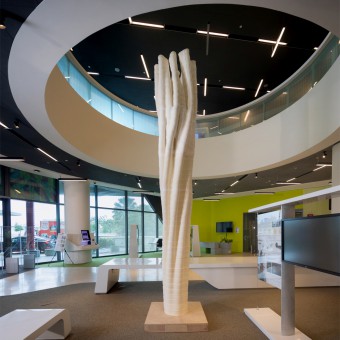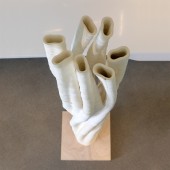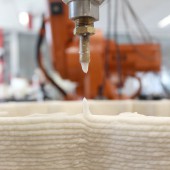Natural Composite Pillar Research Prototype by Stylianos Dritsas and Javier Fernandez |
Home > Winners > #72873 |
 |
|
||||
| DESIGN DETAILS | |||||
| DESIGN NAME: Natural Composite Pillar PRIMARY FUNCTION: Research Prototype INSPIRATION: The purpose of the research work is to address the environmental repercussions of the uncontrollable use of synthetic polymer plastics. We aimed to create a new material process that offers a sustainable alternative. The material is a bioplastic that does not include petrochemical adhesives or chemical solvents associated with adverse human and environmental effects. UNIQUE PROPERTIES / PROJECT DESCRIPTION: The prototype is one of the largest 3D printed biological artifacts today, created using a novel sustainable manufacturing technology deploying exclusively natural materials. Those include cellulose, which is the most abundant biomaterial on earth, commonly associated with plant matter, and chitin, a biomolecule extracted from the exoskeleton of insects and arthropods. OPERATION / FLOW / INTERACTION: The prototype demonstrates the possibility for creating large-scale self-supporting objects using the 3D printing. PROJECT DURATION AND LOCATION: Production started in June 2018 and finished in October 2018, and currently exhibited at the Singapore University of Technology and Design. |
PRODUCTION / REALIZATION TECHNOLOGY: We developed a large-scale additive manufacturing technology for natural biomaterials comprised of an industrial robot and a viscous colloid dispensing system. The physical and mechanical material properties are in the range of high-density synthetic foams and low-density timbers. The material is based on renewable sources, widely available in nearly every ecosystem and naturally biodegradable. SPECIFICATIONS / TECHNICAL PROPERTIES: The pillar measures between 0.6 and 1.0 m in diameter, 5m vertically and weights 100kg. It was printed in 50 vertical segments, adhered with the same material into larger blocks. Printing required approximately 60 hours with 0.5 to 2.0 hours per segment. TAGS: Sustainable Design, Additive Manufacturing, Natural Composites, Digital Fabrication, Bioinspired Design RESEARCH ABSTRACT: Despite decades of extensive research, bottom-up use of cellulose is still plagued with problems that restrict its practical applications: derivatives with polluting effects, use in combination with plastics and high production cost. We believe additive manufacturing with ubiquitous biological polymers will become the catalyst for transitioning towards environmentally benign and circular models of manufacturing and design. CHALLENGE: Unlike synthetic polymers, natural materials are characterized by their innate variability; no two pieces of wood are ever the same. Here the material between its 3D printed and cured states loses 4/5ths of its weight. To enable the production of the composite pillar we developed machine learning models that embed and predict material behavior. ADDED DATE: 2018-11-28 17:26:19 TEAM MEMBERS (6) : Architect Engineer: Stylianos Dritsas, Material Scientist: Javier Fernandez, Post-Doctoral Researcher: Naresh Sanandyia, Research Graduate: Yadunund Vijay, Research Assistant: Samuel Halim and Research Assistant: Ryan Teo IMAGE CREDITS: Image #1: Frank Pinckers Image #2: Frank Pinckers Image #3: Frank Pinckers Image #4: Frank Pinckers Image #5: Samuel Halim |
||||
| Visit the following page to learn more: https://www.nature.com/articles/s41598-0 |
|||||
| AWARD DETAILS | |
 |
Natural Composite Pillar Research Prototype by Stylianos Dritsas and Javier Fernandez is Winner in Sustainable Products, Projects and Green Design Category, 2018 - 2019.· Press Members: Login or Register to request an exclusive interview with Stylianos Dritsas and Javier Fernandez. · Click here to register inorder to view the profile and other works by Stylianos Dritsas and Javier Fernandez. |
| SOCIAL |
| + Add to Likes / Favorites | Send to My Email | Comment | Testimonials | View Press-Release | Press Kit |







